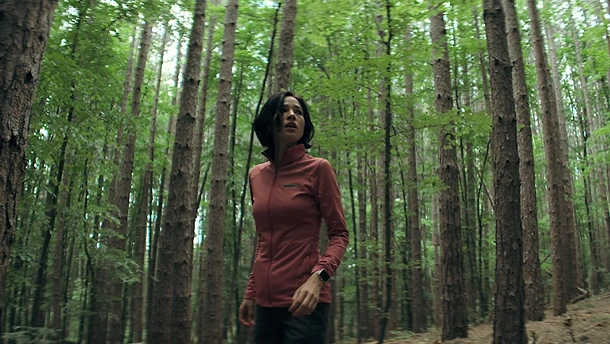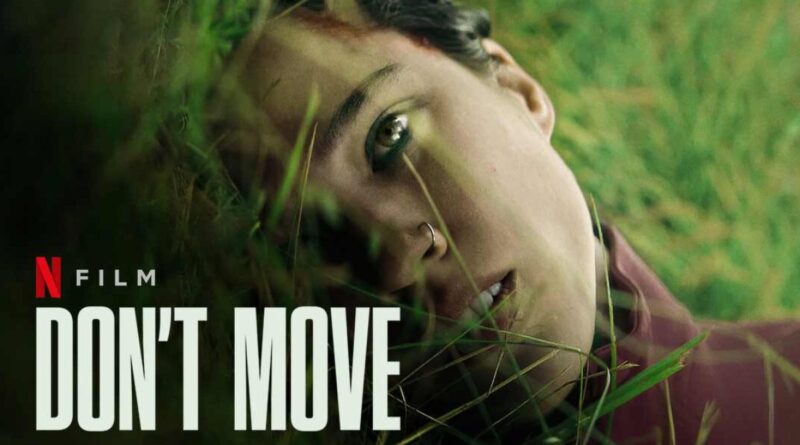“Don’t Move” Won’t Paralyze You From Tension, But Has It’s Moments | Review
If there were a list of the Ten Commandments for horror movies, “Don’t Move” might rank very high. We’re all familiar with the scenes where the protagonists hide from a creepy killer, villain, monster, ghost, or whatever in complete silence, aware that any sound could reveal them (and, of course, they’ll make a lot of unnecessary noise to create tension, etc.). So when I heard about a horror movie on Netflix called “Don’t Move” and read the plot description, I knew in advance what to expect: a thriller that has an integral part to do with the heroine’s ability to move, or mainly her inability to. Hoping that the thriller would be compelling and would also keep me glued to the couch, like, for example, the excellent “Don’t Breathe,” in which I held my breath along with the protagonists, or some of the “A Quiet Place” films, in which I also tried not to make a sound.
“Don’t Move” hit Netflix’s catalog a few months ago and quickly shot to number one on the viewing charts. Despite this fact, and perhaps because of it, I came to the film with low expectations. I was hoping for a movie that would take me about an hour and a half, without using my head too much, with any extras – say, excellent acting, tension, compelling scenes, etc. – being a bonus. The bottom line of the following “Don’t Move” review is that the movie delivered the goods but didn’t offer much more.
What Is The Don’t Move Movie About?
“Don’t Move” begins with panoramic landscape shots, as befits a horror movie that will involve a woman’s survival against a crazy man and the forces of nature. The heroine is a girl named Iris (Kelsey Asbille, who we know mainly from television and series like “Yellowstone,” Disney’s “Pair of Kings,” and “Teen Wolf”) who arrives at the pastoralist California State Park, ostensibly to take a walk and enjoy the scenery. We quickly discover that the reason is different when we see her son’s memorial site. Later, we realize that he fell off the same cliff to his death during a family hiking trip and that the unfortunate mother is there to do the same thing: Meaning to commit suicide.
Suddenly, Iris hears the voice of a mysterious, kind but slightly creepy-looking guy (Finn Wittrock, nominated for two Primetime Emmy awards for “American Horror Story: Freak Show” and “The Assassination of Gianni Versace: American Crime Story”). He introduces himself as Richard, tells her a little about his personal story that includes a similar trauma, and tries to convince her not to jump with the help of some empowering phrases, which he probably found on Google or in some shitty Facebook pages offering silly memes and quotes that suppose to give you inspiration or something like that, but mostly annoy you.
For some reason, it works. Iris listens to Richard, decides not to end her life, and accompanies him. When the two arrive at the reserve’s parking lot, where we discover that Richard is probably an awful driver who doesn’t know how to park the car or just doesn’t give a damn about others trying to park their car, we realize that he set up the whole thing: he stabs her with an umbrella (!). Later, she will discover that he has injected her with some substance, which will cause her to gradually lose control of her body for some fake biological reasons. Within about 20 minutes, she will be completely paralyzed, and he will be able to carry out his plan in her over the weekend in an isolated cabin.

Iris, who until a few minutes ago was thinking about committing suicide, discovers her survival instinct and begins to fight for her life against the dude who seems to be a mysterious serial killer. As you can expect from these types of movies, she soon had to fight against the forces of nature (ants, a busy river, and so on).
As you can tell from the “Don’t Move” plot synopsis, get a reasonably routine fight between cat and mouse, with a twist related to the race for time, which is supposed to add to the film’s suspenseful structure – primarily when the likable killer details several times exactly what is supposed to happen to her body at each stage of the process.
As is customary in films of this type, there will be several rescue attempts by characters that it is clear to the average viewer will not succeed in saving the character – because then the film would be over in half an hour – and that the killer may kill them because that’s what makes them killers.
The Problem: There Is Not Enough Tension
“Don’t Move” has all the potential to be a typical but enjoyable B-movie. Its directors, Adam Schindler and Brian Netto, are reasonably unknown to the broad audience. The actors have done some fine projects on television and in film, but it is difficult to say they are part of Netflix’s “talents,” like Millie Bobby Brown or Adam Sandler. The most familiar name here, certainly for horror fans, is on the list of producers: the genius Sam Raimi, who is responsible as a director for the masterful “Evil Dead” trilogy and the successful “Drug Me to Hell,” and as a producer for films such as “Don’t Breathe,” “The Grudge” and “65”.
The relatively low budget of “Don’t Move” dictates a somewhat limited location, a limited number of characters, and a straightforward plot. These are both its weaknesses and strengths. Because we end up with a film that does “flow,” but sometimes at a pace that is too slow or fast. Although it tries to simulate the viewer’s time with that of the character, I did not feel helpless and panicked even when the character gradually lost her ability to move her fingers, move, communicate, and so on. This lack of identification may stem from the uneven pace of the film, from the script that includes many holes, from insufficiently developed characters, or for other reasons, but the result is mostly reasonable.

Part of the blame may lie with the script. The actors got, at times, very little to work with. Asbille is forced to communicate for most of the film with almost no physical gestures, using her eyes and the like, and it’s hard to deliver emotions to the viewers in such terms. They did a great job, but there was enormous room for improvement.
The dialogue is one of the film’s main weaknesses, as some lines here sound mechanical or just unbelievable. When the mysterious villain makes up stories to fuel the suspicions that arise in the supporting characters who are supposed to save the heroine, it’s hard for the average viewer to believe that they only “suspect something is wrong” but don’t take more active action that would also provide them with protection if these suspicions turn out to be true (we’re mainly referring to you, Mr. Police Officer).
Something Happens To The Body, It Seems
As in many other cases, one of the primary keys to “Don’t Move” pleasure is to leave logic behind. In “Play Dead” with Bailey Madison and Jerry O’Connell, for example, we had to humbly accept the opening point (a girl who takes a substance that will make her dead for a certain period to enter the morgue) to get an enjoyable and suspenseful film. In this case, you should equip yourself with a certain degree of suspension of disbelief in fiction. Despite this, the film remains relatively logical and manages not to be too absurd.
To the filmmakers’ credit, they didn’t try to confuse us with stupid names of materials, drugs, or whatever, physiological processes, and body mechanics, which might have caused science lovers to look for illogical errors and mistakes here. For example, I remember watching “The Age of Adaline” with my wife, a doctor by profession, who laughed out loud at all the physiological explanations and computer animations that were supposed to explain what was happening on the screen.
“Don’t Move” focused mainly on the bottom line, which is the processes on the body, from a safe place that was perhaps aware of the limitations of films in conveying overly complex biological ideas (whether true or not). There may be logical errors here, but to the film’s credit, it tried to downplay them.

When You Identify With Basically No One
Another difficulty is that the film doesn’t do enough to develop the characters, which could perhaps create identification and increase the emotional effect – and by the way, this emotional depth can also be with the killer. In Alfred Hitchcock’s brilliant “Psycho” we identify for a few seconds with Norman Bates’ fear that the car he is trying to sink in a lake to hide evidence will not sink completely, which is considered one of the classic examples of creating tension related to the fate of a character we are not supposed to be in tension with.
In “Don’t Move,” in contrast, I did not identify with any of the characters. Their very general description from the first paragraphs of the review, of a grieving mother who wants to commit suicide or a serial killer who collects and paralyzes women, is maintained almost throughout the film without too much development. The attempts to add some emotional depth were predictable and trite, such as a phone call in which we discover that the killer is actually a family guy, that he has a daughter who gets good grades in school, but would like to see her father more, and so on.
Like several films we’ve seen in recent years, for example, “Night of the Hunted,” which depicts the life-and-death struggle of a bitchy woman in a gas station convenience store against a mysterious sniper, we get the feeling that some of what we see on screen is random. There is some explanation for the killer’s behavior, but it is meager and unsatisfactory.
Paralyzed, But Not A Sucker
To the heroine’s credit, she behaves rationally and avoids stupid mistakes that increase her chances of dying. The process that Iris goes through, from a woman who wants to commit suicide to one who struggles to survive heroically, seems problematic on paper. However, according to my pretty minimal knowledge of psychology, the situation described here may be quite natural: the instinct for survival and staying alive, which, in the moment of truth, wins all depression, trauma, and a desire to end them. According to reports, many people who tried to commit suicide by jumping but survived said they regretted jumping as soon as they were in the air.
“Don’t Move” actually draws a parallel between the physical process that the heroine goes through and a general and more profound idea that depression or even the grief experienced after trauma can be paralyzing. You can see it as presenting a metaphorical notion of dealing with Loss, who is a central villain here (if you will, in much the same way that “The Babadook” treated Loss and presented it as a monster in the darkness of the house), without too much depth.
As long as the film is conducted in a “too direct” manner and leaves the metaphorical ideas to the imaginative viewer – I, for example, wondered at one point if we would get a twist in which we would understand that the killer does not exist, but is the alter ego or different personality of the girl who expresses her struggle between life and death – it somewhat misses the opportunity to be truly unique and interesting. Even if the film had only made the viewer doubt a little what he sees through the presentation of the heroine as mentally unstable (yes, pills that cause hallucinations and the like), perhaps we would have activated our brains a little more, trying to figure out what exactly is going on here.

Should You Watch Don’t Move?
For the most part, “Don’t Move” struggles to be unique and make the viewer feel what he needs to feel in these kinds of movies (tension, anxiety). Some people may see it as too routine, a boring film, or at least a movie that starts well but loses the plot as it proceeds. It is less effective than other films with a similar idea, which present a chase between the hero or heroine and a serial killer in a limited location: for example, the impressive “Alone” from 2020, which featured one of the more sophisticated heroines in recent years, or even “Unhinged” with Russell Crowe, one of the last films he made before he became possessed on set and turned him into an actor who mainly plays in films about exorcisms.
On the positive side, “Don’t Move” is far from a catastrophe. It has some tense and compelling moments, and the director manages to make the most of the location (the film was shot in Bulgaria) and the limited cast, which does the job at most. “Don’t Move” has trouble becoming genuinely unique and original, and there are much more successful, suspenseful, and scary films in its subgenre.
“Don’t Move” is mainly suitable for casual late-night viewing, as befits Netflix films. In an inevitable and ironic contrast to its name, it is primarily suitable for those looking for a passive experience during the hours we are supposed to sleep. It is a film you watch to enjoy or pass the time and forget about it about 20 minutes after it ends.
“Don’t Move” – Everything You Need To Know
Year: 2024
Directors: Adam Schindler and Brian Netto
Actors: Kelsey Asbille, Finn Wittrock, Moray Treadwell, Daniel Francis
Screenplay: TJ Cimfel, David White
Running Time: 92 minutes
Country of Origin: United States
Language: English
Parents Guide: R
Release Date: October 25, 2024
Ratings:
IMDB: 5.8
Rotten Tomatoes: 72%
💀 Killer Deals & Scary Recommendations 💀
🎭 Costumes & Accessories
HalloweenCostumes Fun Costumes Entertainment Earth
🛒 Online Shopping
AliExpress Amazon Walmart Etsy
🧛 Collectibles & Horror Brands
Funko Hot Topic Lego Spirit Halloween
🎢 Attractions & Tours
GetYourGuide Tiqets Viator Klook
📖 Blogs & Horror Sites
Bloody Disgusting iHorror Fangoria
🩸 Disclaimer: Some links are affiliate links. The price stays the same – it just helps keep the site alive 👻




